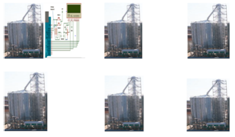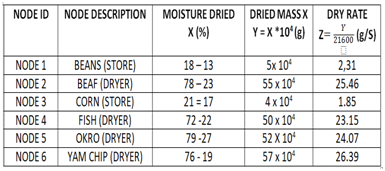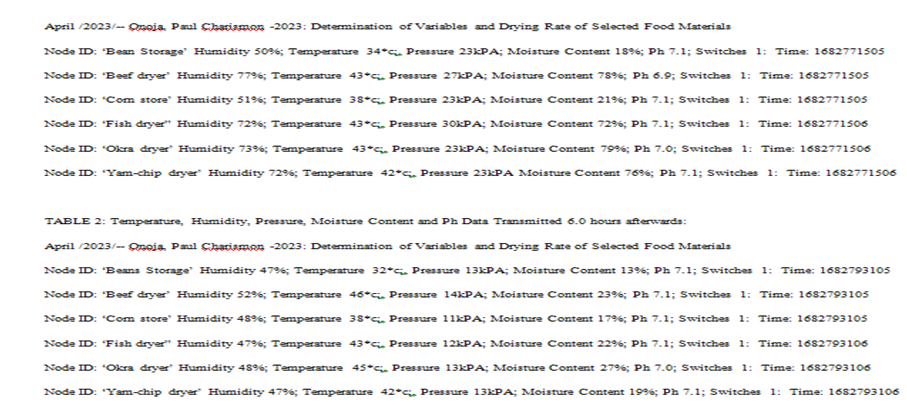Esp32 -Wifi Based Integrated Supervisory Farm-Stead Crop Drying System for Sustainable Development of Agricultural Industries
- Onoja, Paul
- 85-90
- Nov 10, 2023
- Agriculture
Esp32 -Wifi Based Integrated Supervisory Farm-Stead Crop Drying System for Sustainable Development of Agricultural Industries
Onoja, Paul
Department Of Mechanical Engineering, Benue State Polytechnic, Ugbokolo
DOI: https://doi.org/10.51584/IJRIAS.2023.81010
Received: 02 October 2023; Revised: 06 October 2023; Accepted: 10 October 2023; Published: 10 November 2023
ABSTRACT
A system for the collective observation of dynamic variables and drying characteristic of multi-agent (distributed) on-farm drying of food materials is the subject of this discourse. Sensed real-time signals from instrumented farms-stead drying operations are transmitted and collectively displayed at a central hub using the ESP32- wiFi, Internet of Things (IoT) technology. The precise real-time display of sensed temperature, humidity, pressure and moisture content shows the ease and economy by which supervisory responsibility for distributed multi-agent functions could be managed with as many as five (5) supervisors spared their responsibility on the farms to focus on other tasks. The same services received greater efficiency and accuracy to enhance process quality and sustainability. The system is recommended for the Nigeria agricultural clime with its limited farm sizes and constrained Mechanization.
Keywords: collective observation, dynamic variables, drying characteristics, multi-agent on-farm drying, ESP32-WIFI based Internet of Things.
INTRODUCTION
Nigeria’s agricultural system is based on distributed, small and medium sized farms with seasonal output and wasteful handling and storage techniques. For several decades research focus has shifted from land use solution to technology, and to various other scientific approaches with conferences and workshops calling for attention, support and adaptation of relevant findings. Farmers and associated businesses are constrained to single farm-stead and limited mechanization with poor returns on investment. Government interventions (inputs) have been deployed towards providing agricultural resources to stimulate industrialization. However, high cost of energy, labour, equipment and lack of critical skills to manage and assemble the products within easy reach of the industries keeps stalling development. Food prices continue to be very high as most farm produce are being lost after harvest.
This paper reviews the conclusions of an earlier research on the relevance, feasibility and sustainability of the ESP32-WIFI based instrumentation and control system proposed against slow, wasteful, labour, and energy costs of distributed, mechanized services. The paper searched books, journals and related publication to interrogate the demonstrated relevance, feasibility and sustainability of deploying instrumentation and control technology to the solution of the complex problem of backward agricultural system.
The display of precise, real-time temperature, humidity, pressure, moisture content and ph values (drying and storage characteristics) from different workstations (farms-stead) at a selected location indicates the feasibility of integrating supervision (and control) of distributed functions to eliminate demand for multiple human agents, substitute men and material movement with signal transmission and maintain prescribed quality control actions in the processes. The system reduces the number of human agents from six (6) to only one, delivering accurate result whilst taking away much of the needed material and human movement.
Background of the Study
Nigeria’s agricultural economy is marked by small and medium scale operations that keep losing investment and getting abandoned. Industries are built, run for a short period and fold up due to drop in supply of raw materials. Food supply is very seasonal with high retaining costs driving food prices beyond the reach of over 75% of the populace. Thus food security has not been realized and the export function remains a mirage as 14 % of global food produce are still lost after harvest (FAO, 2019).
Researchers and other professional bodies have continued to call for government aid in provision of inputs for farming and other processing activities. However, the vicious cycle of value chain problems continues to keep Nigeria below the standard of global food security. FAO (2019) further noted that insights into how much food is lost as well as where and why at the different stages of the supply chain calls for decisions for effective education and also contribute to a number of sustainable development goals.
Sustainable development of agricultural industries is predicated on the deployment of lean processing techniques with the prospects for efficient value chain services, energy efficient services, Environmental friendly operations, Competitive product quality output, cost efficient entrepreneurship.
Harry, (2018) observed that using Arduino and smaller boards makes the diverse functionality and power of micro controllers applicable for everyday household tasks as well as bringing fun and creativity to engineering. They allow us to program the micro controller within the reach of our creative capability. George and Yufeng (2016), noted that electronic sensors, instrumentation and computers are used for scientific data acquisition and process control in modern agricultural and Biological systems.
Stuart, N (2021) defined physical computing as building physical systems with hardware and software that integrate, feel and respond to the analog world. He further explained that the internet of things (IoT) refers to the ability to interact with physical devices to obtain information (e g. temperature, pressure, humidity, etc.) and send commands /actions (e.g. Move, stop, light, etc).
Chinmay, et al. (2018) wrote that the development of precision farming technologies in the 1990s open up a new way of mechanizing crop management. It led to the adaptation of some concepts to variability management, yield mapping and variable rate treatment facilitating assessment and treatment of the spatial scale of variability within the mechanized system. While precision farming did not have the means to deal with spatial and temporal variability, the smart technology however have reduced variable scale treatment from farm scale to field scale, sub field scale and plant scale to even leaf scale treatment.
Instrumentation is the act of producing devices for monitoring, measuring and controlling a process (automated systems). It enhances the ease and quality of manufacturing and other controlled processes. Instrumentation involves much mathematical and problem-solving skill (Chinmay, et al 2018).
Adopting the multi-agent system for monitoring and control of machines and processes leads to improved productivity, reliability and safety without the drudgery of human involvement. It ensures that the plant operates within the defined parameters to produce materials of consistent quality and class specifications, the plant operate safely and corrects out-of-tolerance operation or automatically shut-down the system to prevent hazardous conditions (Chinmay, et al 2018).
Several other related and /or interconnected operations could be instrumented for efficient handling of food processing such that integrating all instrumented and controlled processes would facilitate efficient handling of raw materials for advanced processing activities of major industries to promote sustainable export business.
METHODOLOGY
Samples of beans, beef, corn, fish, okra, and yam were collected, weighed fresh (5kg) each and oven dried, to determine their initial moisture contents. Fig. 1 is the table of the mean results for replicated tests.
Table 1: Computed Values of Moisture Content for Selected Food Products
| S/No. | Sample Description | Sample Mass (Kg) | Dry Mass (Kg) | Dried Moisture (Kg) | Moisture Content (%) |
| 1 | BEANS | 5 | 4.1 | 0.9 | 18 |
| 2 | BEEF | 5 | 1.1 | 3.9 | 78 |
| 3 | CORN | 5 | 3.5 | 1.5 | 21 |
| 4 | FISH | 5 | 1.4 | 3.6 | 72 |
| 5 | OKRO | 5 | 1.05 | 3.95 | 79 |
| 6 | YAM CHIPs | 5 | 1.2 | 3.8 | 76 |
Six (6) workstations: A (beans storage), B(beef dryer), C (corn storage), D (fish dryer), E (okro dryer) and F (yam-chip dryer) were installed with sensors, an ESP32-WIFI module and an LCD screen for measurement, transmission and display of temperature, humidity, pressure, moisture content and Ph values.
The sensed moisture signals for the samples in the instrumented drying systems were calibrated the computed moisture content in table 1 as reference values.
The process flow chart in fig. 2 is used to code, replicate for all six (6) stations to monitor, transmit and display readings on the LCD screen at the control hub.
Figure 1 Drying System Flow Chart
Changes in the variables were allowed to stabilize and screen shot. The readings were screen shot again after six (6) hours (Appendix 1). The results of the drying function were manually computed and tabulated as in Table 2.
The application code is installed in the different circuits and deployed to the integrated control station.
Figure 2: Integrated Supervisory Farm-Stead Crop Drying System
RESULTS AND DISCUSSIONS
Table 2: Computed Values of Drying Rate for Selected Food Products.
The moisture content changes notably with sustained low relative humidity, high temperature and low pressure. Increasing the warmer temperature and blower speed causes a significant increase in the rate of loss of moisture. Hence the variables of humidity, temperature and pressure have significant, real-time effect on the drying characteristic of the selected food materials. However, the pH varies negligibly within a range of 7.0 +/- 0.15 inferring non toxicity of the products.
The system is easy and economical to develop and operate: low cost of components, assembly and installation, ease of operation with reduced human supervisors from six (6 to One 1), replacing six (6) pallet trucks, their drivers and fuel use with energy efficient electric motors, replacing six (6) security personnel/ gate-men while security cameras, automated doors and switch gears,
Low energy and labour demand translates to a lean production system with cleaner and safer environment.
The accuracy of the system encourages higher quality products for competitive entrepreneurial services.
Re usability and extend-ability of the application is also key to a seamless switching of entrepreneurship portfolio over different periods and products in the seasonal agricultural condition.
CONCLUSION AND RECOMMENDATION
The system is both relevant and feasible for product handling and management of multi-agent farm processing operations. Data from the instrumented hard-ware/soft-ware units of many work stations could be transmitted and integrated at a control centre (hub) to cut cost of human supervision. Further development such as machine learning and full automation are sustainable advances into Agricultural technology for food security.
Farmers and agricultural entrepreneurs should adopt digital instrumentation and control technology as a means to achieving sustainable business, food safety and economic development.
REFERENCES
- Harry, H. C. (2018). Learning Physical Computing with Arduino for the Absolute Beginner. (VER. 2.0) UC Davis Center for Integrated Computing and STEM Education (C-STEM) @ http://c-stem.ucdavis.edu
- FAO, (2019). The State of Food and Agriculture 2019: Moving Forward on Food Loss and Waste Reduction towards Achieving Sustainable Development Goals. UN, FAO. Rome. @ https://www.un.fao.sdg.
- George E. M. and Yufeng G. (2016). Instrumentation and Control Instruction for Agricultural and Biological Engineering Students. The American Society of Engineering Education (ASEE)
- Hans, P. H. (2018). Programming with Arduino. 978-8269-1106 @ http://www.halvosen.blog
- Stuart, N (2021). Arduino Programming. ***
- Chinmay, D. J., Dipalii, D., Mahesh, A. B., and AMRUTKAR, k. j. (2018). Farming Automation Using PLC., a PUNE Research Discovery; an International Journal of Advanced Studies (ISSN:-2455-9202) vol3, issue 2.
- Atlas Scientific (2020), PH Probe Calibration Explained. @ atlas scientific.com (31 -12-
APPENDIX 1
Screen shot display of Temperature, Humidity, Pressure, Moisture Content and Ph Data Transmitted




